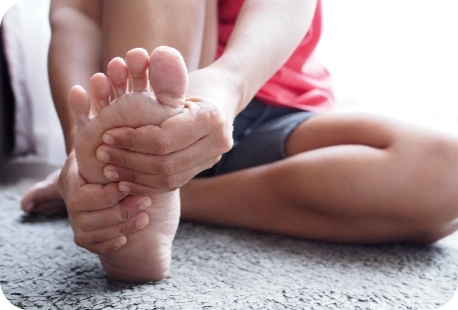

Physicians
Search

GENERAL INFORMATION
Treatment of foot conditions can be a complex process due to its large number of bones, joints, muscles, tendons and ligaments. The foot and the ankle provide support, shock absorption, balance and several other functions that are essential for standing and motion. Puget Sound Orthopaedics (PSO) foot and ankle surgeons use the most advanced surgical and nonsurgical treatments including braces, orthotics and minimally invasive surgery to help patients get back on their feet.
The foot is divided into three sections: the hindfoot (heel and ankle bones), midfoot (bones that form the foot’s arch) and forefoot (toe bones and adjacent long bones). The combined number of bones in the each foot – 28 in all – makes up approximately one-quarter of all of the bones in the human body. There also are 30 joints in the foot, allowing for flexibility and a wide range of movement. The largest bone in the foot is the calcaneus (heel bone). The calcaneus and talus (the bone that sits above the heel bone) are responsible for side-to-side movement.
While arthritis can take many forms, osteoarthritis (“wear-and-tear”) can cause inflammation of one or more of the joints in the foot. Rheumatoid arthritis and post–traumatic arthritis also are common types of arthritis that can affect the foot.
A bunion is a bump in the bone along the inside of the foot around the big toe. A bunionette is similar and is found on the outside of the foot around the little toe. The bony bump forms at the joint, where the phalanx (toe bones) and metatarsal (long bones above the phalanx) meet. Wearing shoes that don’t fit properly can lead to bunions, corns, calluses and hammer toe.
Two major complications of diabetes that affect the foot are nerve damage and poor circulation. A foot affected by diabetes can lead to loss of sensation in the foot, skin infections and a susceptibility to incurring a high number of broken bones.
Pain in the heel is typically caused by plantar fasciitis, a condition that occurs when the plantar fascia ligament (tissue located in the bottom of the foot that connects the heel to the front of the foot and supports the foot’s arch) becomes irritated and inflamed.
Stress fractures are typically caused by overuse and are small cracks or bruises within the bone. The foot bones are vulnerable to these fractures because of the forces they absorb during walking, running and jumping.
Seek medical treatment from an ankle and foot specialist if you are experiencing any of the following symptoms:
Your doctor will discuss all treatment options with you. The best treatment for your injury or condition will be determined in combination with your overall health.
There are several nonoperative treatment options for foot pain. These might include braces, orthotics, physical therapy and pain management in the form of over-the-counter or prescribed medications and/or anti-inflammatories. If surgery is necessary, then PSO foot and ankle specialists can perform a wide variety of procedures ranging from minimally invasive to major reconstruction.
Our specialties extend beyond what you see here. If you have a special need, make an appointment with us!